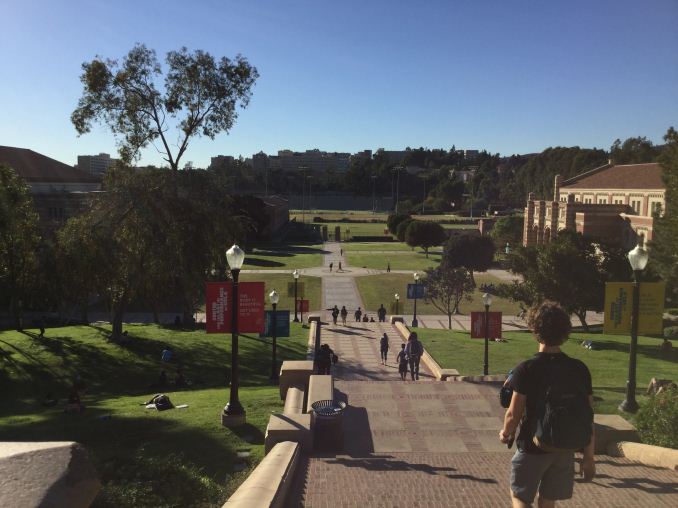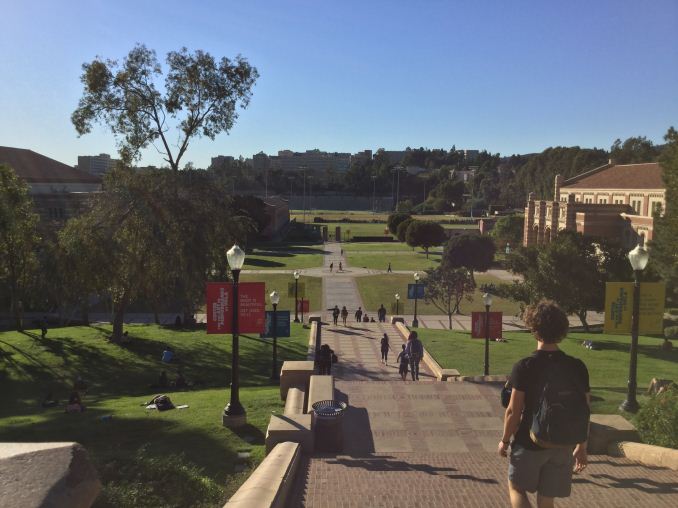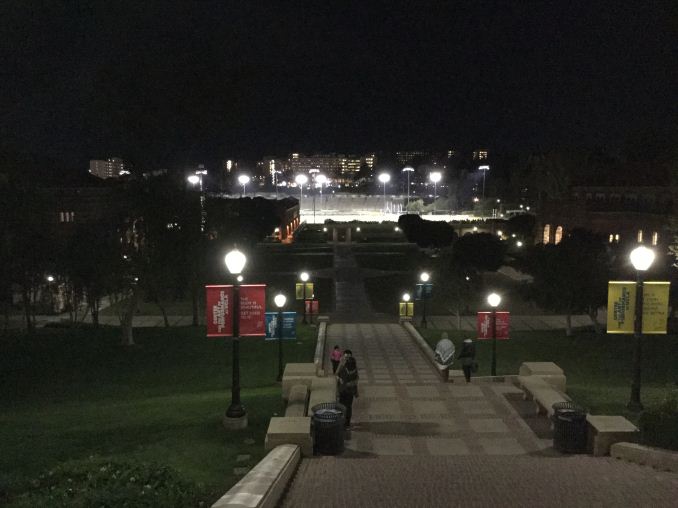The Apple iPad Air 2 Review
by Joshua Ho on November 7, 2014 9:30 AM EST- Posted in
- Tablets
- Apple
- Mobile
- iOS
- ipad Air 2
Camera
For better or worse, the camera on a tablet has become increasingly important. While there was a time when the cameras on tablets were solely used for video calls and similar functions where quality was of relatively low importance, there’s been a clear shift in the other direction. While I don’t think anyone is going to use their tablet as a primary camera, there is a level of convenience that comes with it. I’ve definitely found it to be rather intensely uncomfortable to use a tablet as a camera at all as it’s the furthest thing from inconspicuous. This brings us to the iPad Air 2, which brings the first notable camera change to the iPad line since the iPad 3, as seen below.
| Rear Facing Camera Comparison | |||||||
| Sensor | Resolution | Aperture | Focal Length | ||||
| Apple iPad Air 2 | 8 MP | 3264 x 2448 | f/2.4 | 3.3mm | |||
| Apple iPad Air | 5MP | 2592 x 1936 | f/2.4 | 3.3mm | |||
| Apple iPad 4 | 5MP | 2592 x 1936 | f/2.4 | 4.3mm | |||
| Apple iPad 3 | 5MP | 2592 x 1936 | f/2.4 | 4.3mm | |||
| Apple iPad 2 | 0.7MP | 960 x 720 | f/2.4 | 2.0mm | |||
| Apple iPad mini | 5MP | 2592 x 1936 | f/2.4 | 3.3mm | |||
While the iPad Air 2’s camera does have an eight megapixel output image, it’s important to distinguish this from the iPhone line as the sensor is noticeably smaller than what we see on something like the iPhone 6 and 6 Plus. Instead of 1.5 micron pixels, this gives us 1.1 micron pixels. In addition, the camera lacks PDAF, so focus times will definitely take a fall as a result. On the flip side, this also means no camera hump on the back.
While focus times are one thing, the difference in pixel sensitivity is likely to be the biggest difference. In casual testing, the ISO of the rear-facing camera goes between 25 and 800 ISO, and the front-facing 1.3MP camera will vary between 50 and 2000 ISO. As the tablet lacks optical stabilization, Apple has capped exposure time to a maximum of 1/15 seconds similar to what we see with the iPhone 6.
As one might guess, this difference in sensitivity doesn’t actually make for a significant difference in daytime. While 1.1 micron pixels are relatively small, daytime resolution isn’t all that far off from the iPhone 6. The extremely low sensor gain means that the impact of lower pixel sensitivity isn’t all that significant. It’s clear that the A8’s ISP does a good job of preserving detail while removing noise as we don’t see loss of detail in low contrast areas and noise in general is hard to see outside of the sky.
HDR is also quite good as one might expect, with no perceivable halos or ghosting effects from moving objects.
Unfortunately, in low light we see the weakness of the smaller pixel sizes as a significant amount of noise creeps in. This is especially obvious in preview as noise reduction doesn’t seem to be running at that point. Given the amount of noise in the preview, it’s still quite impressive how Apple manages to make the best of a system that isn’t really designed for low light photography. While a great deal of low-contrast detail is gone, there is a great deal of detail preserved and such images definitely good enough to put online if necessary. I don’t see any major color noise in the image, and luminance noise strikes a good balance between excessive blurring and obvious speckle.
In video, we see a similar pattern. On the whole, the iPad Air 2 benefits from the shared ISP from the iPhone 6’s A8 SoC as the EIS solution is surprisingly effective at suppressing high-frequency shaking. In daytime, detail in video is surprisingly good and quite close to what we see with the iPhone 6 line of devices. The one noticeable weakness is that due to the lack of PDAF, it’s necessary to stop and tap to focus on specific objects to maintain detail. There is auto-exposure, but video performance overall is a bit weaker than what one would get from the best smartphone cameras available. We see the same 17 Mbps bitrate encoded with H.264 high profile here as on the iPhone 6.
The iPad Air 2 also has a slow motion mode, which does 120 FPS at around 31 Mbps encoded with H.264 high profile and plays back at 30 FPS. The resolution is 720p, which is in line with other iOS devices for slow motion.
Once again, in low light we see the weakness in the smaller sensor. There’s a great deal of noise visible throughout the video, although there is an acceptable amount of detail and frame rate remains relatively high.
Overall, it’s hard to really find fault with the camera. While the smaller sensor size and lack of phase-detect focus does make for worse images, the camera can actually take good photos in daytime and usable photos in low light. Video follows a similar pattern as well. As said before, this camera is unlikely to be of any value as a primary camera due to the tablet formfactor. However, for applications that need a camera this should be quite serviceable.































226 Comments
View All Comments
Reckoning - Friday, November 7, 2014 - link
That's cool. Enjoy having a slower device because of your prejudice and ignorance.blackcrayon - Friday, November 7, 2014 - link
Well you almost get your wish, the Nexus 9 seems fine in benchmarks but it lags as if it offers half the performance... Count me in the list of people who use software on a device other than the "OS".darwinosx - Friday, November 7, 2014 - link
Poor hughlle knows nothing about iOS and probably not much about Android. The Nexus 9 has been trashed in one review after another including Android sites like Android Police.What do you like about Android? The malware? The inferior app quality? I know, Google monitoring and selling to advertisers all your activity! Awsum! Maybe fragmentation? How about terrible build quality and support? So much to like....
sonicmerlin - Friday, November 7, 2014 - link
I'm curious if lollipop finally got rid of android's lag and garbage collection stuttering. Otherwise I'll stick to iOS.NEDM64 - Sunday, November 9, 2014 - link
Lollipop can't get rid of garbage collection alone, all apps would have to be rewritten.rdjg22 - Saturday, November 8, 2014 - link
Yes, because Android is so optimized for tablets. I'm an android fanboy too when it comes to phones (N5 is my daily driver), but you'd have to be a blind and dumb fanboy to think android offers a better tablet experience.KoolAidMan1 - Tuesday, November 11, 2014 - link
You choose an OS with substandard apps, weak developer support, and almost no tablet optimized apps over a platform with faster hardware and better apps in every single category?Weird.
TechShark - Wednesday, December 17, 2014 - link
amazon has the iPad Air 2 for $50 off. http://bit.ly/13dl0ssJRX16 - Wednesday, January 7, 2015 - link
I played around with a Nexus 9 recently and found it disappointing. You couldn't pay me to take that over an iPad Air 2. Browsing a graphics heavy website like The Verge was almost impossible, the lag and stutter was unacceptable and made it unusable. With so much power, something is dramatically wrong with either Android or Chrome that it can't handle a website that an old iPad 4 handled with ease. Also, stock Android Lollipop has zero tablet features so it has no benefits over iOS. At least Samsung adds things to make use of the larger screen like split screen multitasking or windowed multitasking. But then their tablets are terrible in terms of performance and battery life. Can't win. The iPad remains king because it gets so much so right.bmbw2010 - Friday, November 7, 2014 - link
I'd love to see what performance they could get out of an A8X in Apple TV hardware, with some higher clock speeds and better cooling.